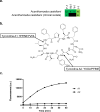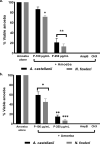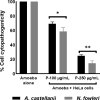Novel Antiamoebic Tyrocidine-Derived Peptide against Brain-Eating Amoebae
- PMID: 36033708
- PMCID: PMC9404165
- DOI: 10.1021/acsomega.2c01614
Novel Antiamoebic Tyrocidine-Derived Peptide against Brain-Eating Amoebae
Abstract
Acanthamoeba castellanii (A. castellanii) can cause Acanthamoeba keratitis, a sight-threatening infection, as well as a fatal brain infection termed granulomatous amoebic encephalitis, mostly in immunocompromised individuals. In contrast, Naegleria fowleri (N. fowleri) causes a deadly infection involving the central nervous system, recognized as primary amoebic encephalitis, mainly in individuals partaking in recreational water activities or those with nasal exposure to contaminated water. Worryingly, mortality rates due to these infections are more than 90%, suggesting the need to find alternative therapies. In this study, antiamoebic activity of a peptide based on the structure of the antibiotic tyrocidine was evaluated against A. castellanii and N. fowleri. The tyrocidine-derived peptide displayed significant amoebicidal efficacy against A. castellanii and N. fowleri. At 250 μg/mL, the peptide drastically reduced amoebae viability up to 13% and 21% after 2 h of incubation against N. fowleri and A. castellanii., whereas, after 24 h of incubation, the peptide showed 86% and 94% amoebicidal activity against A. castellanii and N. fowleri. Furthermore, amoebae pretreated with 100 μg/mL peptide inhibited 35% and 53% A. castellanii and N. fowleri, while, at 250 μg/mL, 84% and 94% A. castellanii and N. fowleri failed to adhere to human cells. Amoeba-mediated cell cytopathogenicity assays revealed 31% and 42% inhibition at 100 μg/mL, while at 250 μg/mL 75% and 86% A. castellanii and N. fowleri were inhibited. Assays revealed inhibition of encystation in both A. castellanii (58% and 93%) and N. fowleri (73% and 97%) at concentrations of 100 and 250 μg/mL respectively. Importantly, tyrocidine-derived peptide depicted minimal cytotoxicity to human cells and, thus, may be a potential candidate in the rational development of a treatment regimen against free-living amoebae infections. Future studies are necessary to elucidate the in vivo effects of tyrocidine-derived peptide against these and other pathogenic amoebae of importance.
© 2022 The Authors. Published by American Chemical Society.
Conflict of interest statement
The authors declare no competing financial interest.
Figures






Similar articles
-
Repositioning of Guanabenz in Conjugation with Gold and Silver Nanoparticles against Pathogenic Amoebae Acanthamoeba castellanii and Naegleria fowleri.ACS Infect Dis. 2019 Dec 13;5(12):2039-2046. doi: 10.1021/acsinfecdis.9b00263. Epub 2019 Nov 12. ACS Infect Dis. 2019. PMID: 31612700
-
Anti-amoebic effects of synthetic acridine-9(10H)-one against brain-eating amoebae.Acta Trop. 2023 Mar;239:106824. doi: 10.1016/j.actatropica.2023.106824. Epub 2023 Jan 4. Acta Trop. 2023. PMID: 36610529
-
Antiamoebic activities of flavonoids against pathogenic free-living amoebae, Naegleria fowleri and Acanthamoeba species.Parasites Hosts Dis. 2023 Nov;61(4):449-454. doi: 10.3347/PHD.23078. Epub 2023 Nov 28. Parasites Hosts Dis. 2023. PMID: 38043540 Free PMC article.
-
Pathogenesis of amoebic encephalitis: Are the amoebae being credited to an 'inside job' done by the host immune response?Acta Trop. 2015 Aug;148:72-6. doi: 10.1016/j.actatropica.2015.04.022. Epub 2015 Apr 27. Acta Trop. 2015. PMID: 25930186 Review.
-
"Proposals for Amendments in the Diagnosis and Treatment of Encephalitis caused by Free-living Amoebae".Infect Disord Drug Targets. 2020;20(2):115-121. doi: 10.2174/1871526519666190405170601. Infect Disord Drug Targets. 2020. PMID: 30961516 Review.
Cited by
-
The Anti-Amoebic Activity of a Peptidomimetic against Acanthamoeba castellanii.Microorganisms. 2022 Nov 30;10(12):2377. doi: 10.3390/microorganisms10122377. Microorganisms. 2022. PMID: 36557630 Free PMC article.
-
The anti-amoebic potential of carboxamide derivatives containing sulfonyl or sulfamoyl moieties against brain-eating Naegleria fowleri.Parasitol Res. 2023 Nov;122(11):2539-2548. doi: 10.1007/s00436-023-07953-w. Epub 2023 Sep 4. Parasitol Res. 2023. PMID: 37665414
-
Next generation imidazothiazole and imidazooxazole derivatives as potential drugs against brain-eating amoebae.Parasitol Res. 2024 Jun 12;123(6):241. doi: 10.1007/s00436-024-08255-5. Parasitol Res. 2024. PMID: 38864931
-
Cyclic Peptide Natural Product Inspired Inhibitors of the Free-Living Amoeba Balamuthia mandrillaris.J Nat Prod. 2025 Feb 28;88(2):274-281. doi: 10.1021/acs.jnatprod.4c00834. Epub 2025 Feb 13. J Nat Prod. 2025. PMID: 39948695 Free PMC article.
References
-
- Mungroo M. R.; Khan N. A.; Siddiqui R. Naegleria fowleri: diagnosis, treatment options and pathogenesis. Expert Opin. Orphan Drugs 2019, 7 (2), 67–80. 10.1080/21678707.2019.1571904. - DOI
LinkOut - more resources
Full Text Sources

